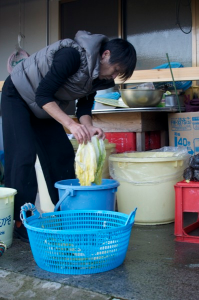This weekend was extended with an extra day due to a National holiday on Friday. We spent it with Sachi-san and friends in Kobuchihama and Fukukiura. Yes, we traveled the 600 km or so to Ishinomaki and then some to the peninsula outside of Ishinomaki where Kobuchihama and Fukukiura are located.
This time it was not to really do any volunteer work but mainly to meet with friends, talk, and spend some money in the area.
The one thing that always hit me when I visit there is how friendly everyone is. We drop by unannounced and they always invite you in, offering something to drink or eat. The food you are offered is almost always self-catched and home cooked – or home prepared because often it is not cooked 🙂
We left Tokyo at 7 am and immediately got of course stuck in traffic, this was after all a long weekend so we were not the only ones traveling the roads. But it sucked nevertheless. We crawled our way out of Tokyo and once central Tokyo was behind us it speed up a bit. Still it was slow progress until after Nikko, 1.5-2 hours ride into our journey.
After a couple of stops and normal speed at the end of the trip we reached our destination around 2:30 pm. Our first stop was the newly built oyster factory in Fukukiura, but they had closed for the day. Instead we visited Haruto-san and his younger brother Kouichi-san in Kobuchihama for a talk.


Kouichi-san was packing sea cucumber in plastic bags for export to China – Chinese seem to like sea cucumber; me I can eat them but they don’t taste much and are kind of crunchy to eat. He also showed us where they dried sea cucumbers and awabi, and we tried a delicious dried awabi. We also got oysters cooked in their shells.

Around dinner time we went to Fukukiura to have dinner with some friends, a family that has helped coordinating the volunteer work in Fukukiura. After the dinner we said good bye and drove to Ishinomaki where we stayed at the Grand Hotel. On our way to Ishinomaki we saw a tanuki (raccoon dog) and about 20 or so rain deers.
On Saturday morning we returned to Fukukiura to visit the oyster factory. It was fun and interesting to see how to prepare the oysters for selling them. Most of the work is done by hand, including cleaning the oysters from blue mussels, open them, washing them to get rid of sand and other things. It seems to be hard and cold work.



We also met Haruto-san at the oyster factory. He was taking some people out in his recovered boat. His boat was pushed up into the forest by the tsunami but was recovered and was now back in a state as new – you can read about Haruto-san’s boat here.

After the oyster factory we visited a nori (dry seaweed) factory. They had quite recently invested a lot of money to automate it. It was interesting to see how the seaweed turned into nori, something that we eat on a regular basis.

It was now time for a coffee break and we, almost as usual, visited one of our friends for it 🙂 While the others were drinking coffee and talking I took a stroll around the house and walked into the woods behind the house. I was interested in what they had done there since the last time, basically they had cut down some of the trees. And I found that some had taken the opportunity to do some wood art.

In the night we went to Meguro ryokan in Kobuchihama. They were full the first night but today they had a room for us, which included dinner and breakfast. We also got a visit during dinner time from some of our friends.

Sunday was return-to-Tokyo day, but before we returned home we drove around visiting friends. Talking and saying “bye” for this time.

Our final stop was at a family where we got oysters, awabi, eel, and pickled Chinese cabbage to bring with us back to Tokyo. This happened almost everywhere we stop and the car was packed with boxes full of nori, eel, awabi, oyster, and even rice.


Before we returned back to Tokyo we also made a brief stop in Ishinomaki to visit some friends there. They invited us for coffee and snacks. We stayed there drinking coffee and talking for a couple of hours before it was time to leave. It was getting dark by the time we were on our way.

Like this:
Like Loading...






















